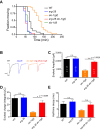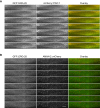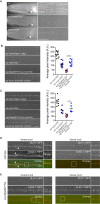ERG-28 controls BK channel trafficking in the ER to regulate synaptic function and alcohol response in C. elegans
- PMID: 28168949
- PMCID: PMC5295816
- DOI: 10.7554/eLife.24733
ERG-28 controls BK channel trafficking in the ER to regulate synaptic function and alcohol response in C. elegans
Abstract
Voltage- and calcium-dependent BK channels regulate calcium-dependent cellular events such as neurotransmitter release by limiting calcium influx. Their plasma membrane abundance is an important factor in determining BK current and thus regulation of calcium-dependent events. In C. elegans, we show that ERG-28, an endoplasmic reticulum (ER) membrane protein, promotes the trafficking of SLO-1 BK channels from the ER to the plasma membrane by shielding them from premature degradation. In the absence of ERG-28, SLO-1 channels undergo aspartic protease DDI-1-dependent degradation, resulting in markedly reduced expression at presynaptic terminals. Loss of erg-28 suppressed phenotypic defects of slo-1 gain-of-function mutants in locomotion, neurotransmitter release, and calcium-mediated asymmetric differentiation of the AWC olfactory neuron pair, and conferred significant ethanol-resistant locomotory behavior, resembling slo-1 loss-of-function mutants, albeit to a lesser extent. Our study thus indicates that the control of BK channel trafficking is a critical regulatory mechanism for synaptic transmission and neural function.
Keywords: BK channel; alcohol; neuroscience; synaptic transmission.
Conflict of interest statement
The authors declare that no competing interests exist.
Figures














Similar articles
-
Presynaptic BK channel localization is dependent on the hierarchical organization of alpha-catulin and dystrobrevin and fine-tuned by CaV2 calcium channels.BMC Neurosci. 2015 Apr 24;16:26. doi: 10.1186/s12868-015-0166-2. BMC Neurosci. 2015. PMID: 25907097 Free PMC article.
-
BK channel density is regulated by endoplasmic reticulum associated degradation and influenced by the SKN-1A/NRF1 transcription factor.PLoS Genet. 2020 Jun 5;16(6):e1008829. doi: 10.1371/journal.pgen.1008829. eCollection 2020 Jun. PLoS Genet. 2020. PMID: 32502151 Free PMC article.
-
SLO BK Potassium Channels Couple Gap Junctions to Inhibition of Calcium Signaling in Olfactory Neuron Diversification.PLoS Genet. 2016 Jan 15;12(1):e1005654. doi: 10.1371/journal.pgen.1005654. eCollection 2016 Jan. PLoS Genet. 2016. PMID: 26771544 Free PMC article.
-
SLO, SLO, quick, quick, slow: calcium-activated potassium channels as regulators of Caenorhabditis elegans behaviour and targets for anthelmintics.Invert Neurosci. 2007 Dec;7(4):199-208. doi: 10.1007/s10158-007-0057-z. Epub 2007 Oct 26. Invert Neurosci. 2007. PMID: 17962986 Review.
-
Ethanol interactions with calcium-dependent potassium channels.Alcohol Clin Exp Res. 2007 Oct;31(10):1625-32. doi: 10.1111/j.1530-0277.2007.00469.x. Alcohol Clin Exp Res. 2007. PMID: 17850640 Review.
Cited by
-
Alcohol and the Brain: Neuronal Molecular Targets, Synapses, and Circuits.Neuron. 2017 Dec 20;96(6):1223-1238. doi: 10.1016/j.neuron.2017.10.032. Neuron. 2017. PMID: 29268093 Free PMC article. Review.
-
Active Zone Trafficking of CaV2/UNC-2 Channels Is Independent of β/CCB-1 and α2δ/UNC-36 Subunits.J Neurosci. 2023 Jul 12;43(28):5142-5157. doi: 10.1523/JNEUROSCI.2264-22.2023. Epub 2023 May 9. J Neurosci. 2023. PMID: 37160370 Free PMC article.
-
De novo phytosterol synthesis in animals.Science. 2023 May 5;380(6644):520-526. doi: 10.1126/science.add7830. Epub 2023 May 4. Science. 2023. PMID: 37141360 Free PMC article.
-
Regulation of Neurotransmitter Release by K+ Channels.Adv Neurobiol. 2023;33:305-331. doi: 10.1007/978-3-031-34229-5_12. Adv Neurobiol. 2023. PMID: 37615872
-
Transcriptional analysis of the response of C. elegans to ethanol exposure.Sci Rep. 2021 May 26;11(1):10993. doi: 10.1038/s41598-021-90282-8. Sci Rep. 2021. PMID: 34040055 Free PMC article.
References
-
- Alqadah A, Hsieh YW, Schumacher JA, Wang X, Merrill SA, Millington G, Bayne B, Jorgensen EM, Chuang CF. SLO BK potassium channels couple gap junctions to inhibition of calcium Signaling in olfactory neuron diversification. PLoS Genetics. 2016;12:e1005654. doi: 10.1371/journal.pgen.1005654. - DOI - PMC - PubMed
-
- Altun Z, Hall D. Muscle system, introduction. In: Herndon LA, editor. WormAtlas. 2009.
Publication types
MeSH terms
Substances
Grants and funding
LinkOut - more resources
Full Text Sources
Other Literature Sources
Research Materials

